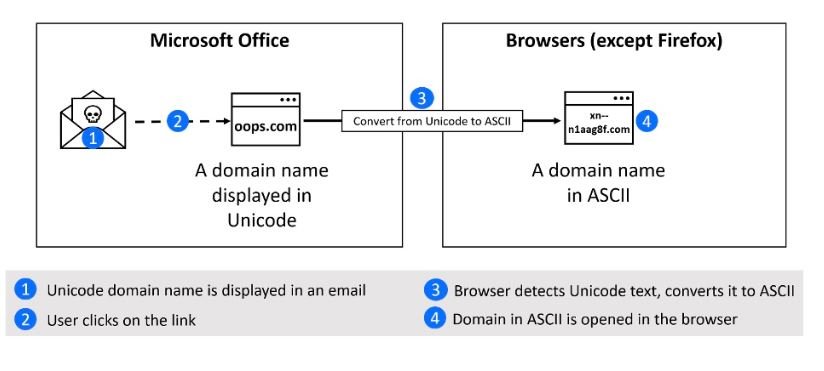A recent report indicates that Microsoft Office applications could be exposed to homograph attacks based on internationalized domain names (IDNs). In a successful attack, a target user scrolling over a link in a phishing email or Word or Excel document could be automatically redirected to a malicious domain.
The report, by Bitdefender, mentions: “Users in a position to validate a link in an email client before clicking on it, will be susceptible to clicking on it because it has not yet been translated into a real domain name in their browser. The actual domain name would only be seen after the page has started to open.”
The term IDN refers to domain names that, in whole or in part use characters from a non-Latin script or alphabet, which are encoded by the Unicode standard. In order for the Domain Name System (DNS) to interpret them correctly, IDNs are stored in the DNS as ASCII strings using Punycode transcription.
Counterfeit IDN homograph domains can be created by combining letters from different alphabets, which to the user look so similar to each other that it is impossible to distinguish them, although Unicode treats them as separate entities. This is not a new concept, although it is still a problem for many users.
Most browsers, for example, display in the address bar the real name of an internationalized domain name (https://xn--n1aag8f.com, for example) instead of the name to display the real name (https://žugec.com) if the site is suspicious. However, Office applications, including Outlook, display the name in another method:

Since domain registration verification greatly limits which counterfeit domains can be registered and most browsers display the real name of the spoofed IDN domain, IDN homograph attacks have ceased to be a constant cybersecurity threat, although threat actors may find ways to deploy these attacks on a large scale.
Microsoft acknowledged the problem when it received the Bitdefender report, though it’s unclear if the issue will be fixed. While the issue is resolved, endpoint security solutions and IP and URL reputation services could collaborate by blocking most suspicious domains.
Feel free to access the International Institute of Cyber Security (IICS) websites to learn more about information security risks, malware variants, vulnerabilities, and information technologies.

He is a well-known expert in mobile security and malware analysis. He studied Computer Science at NYU and started working as a cyber security analyst in 2003. He is actively working as an anti-malware expert. He also worked for security companies like Kaspersky Lab. His everyday job includes researching about new malware and cyber security incidents. Also he has deep level of knowledge in mobile security and mobile vulnerabilities.











